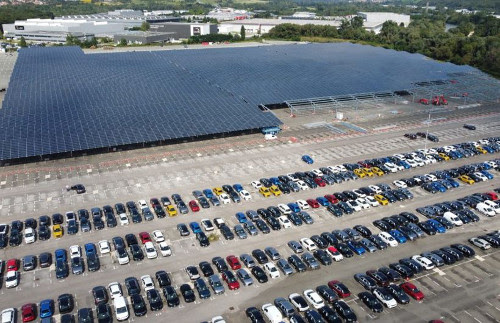8 million homes.
This is how many homes you can power with 11 gigawatts of energy, which typically requires about ten power stations running at full capacity.
Of course, you don’t actually need utility-scale power stations to produce 11 gigawatts.
In fact, in France, the government recently initiated a new program that will ultimately generate 11 gigawatts simply by requiring all car parks with more than 80 spaces to install canopies equipped with solar panels to cover at least 50% of those car parks.
While I’m no fan of government mandates of any kind, and certainly wouldn’t support such mandates here in the U.S., to deny that such a plan is a smart use of resources would be absurd.
After all, from solely a real estate perspective, parking lots are quite inefficient when it comes to utilizing space and generating revenue.
Sure, a parking lot owner can generate revenue by renting spaces to drivers. But parking lot owners could generate even more revenue, and do so with very little effort. In fact, these parking lots could generate revenue even when there are no cars in the lots by installing solar canopies that produce electrons that can be sold back to the grid.
It’s not a common thing just yet, but it will be, as the economics just make sense.
Take the state of Massachusetts, for instance, where parking lot owners that use solar canopies can earn up to $120,000 for every 100 kilowatts of solar installed.
And this doesn’t include savings that are intertwined with solar canopies, such as providing shelter from the snow, thereby decreasing snow plowing costs during the winter. And of course there is the appeal for drivers being able to park under a canopy, which can protect the vehicle from snow, rain, and even heat during the summer months.
Parking lot owners can also use the electricity generated from these canopies to cover their own energy costs.
Take the Santa Barbara County Housing Authority, for instance, which saves more than $1 million per year in electricity costs by using these solar canopies.
Then consider the proliferation of electric vehicles.
More and more parking lots are installing electric car chargers, which can generate additional income. Even more so when those charging stations are being powered by solar.
The parking lot of the future will not just be a blank space. It’ll be covered by solar-mounted canopies. It’ll generate revenue beyond just the parking spot itself. It’ll provide benefits for drivers. And of course, the more efficiently that space is used, the more profitable it will become.
This isn’t about treehugging, folks.
This is about money. Plain and simple.
One company that is likely to benefit from this new car park plan in France is French energy behemoth Engie SA (OTCBB: ENGIY), which has already built a solar carport at a Stellantis factory in Sochaux in eastern France, which makes Peugeots. With 64,000 solar panels over 22 hectares, it will supply around a third of the plant’s electricity needs.
Here’s what it looks like …




